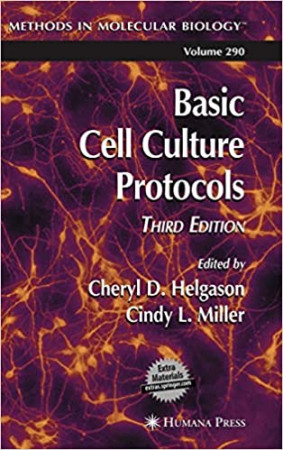Basic Cell Culture Protocols Methodes in Molecular Biology
Keterangan Bibliografi
| Pengarang | : Helgason, Cheryl D. (editor) |
| Pengarang 2 | : |
| Kontributor | : Miller, Cindy L. (editor) |
| Penerbit | : Humana Press |
| Kota terbit | : New Jersey |
| Tahun terbit | : 2016 |
| ISBN | : - |
| Subyek | : Cell culture - Protocols Methods |
| Klasifikasi | : 571.638 Hel b |
| Bahasa | : English |
| Edisi | : Ed. 3 |
| Halaman | : 365 hlm.: ilus. |
Jenis Koleksi Pustaka
E-Book
Kategori Pustaka
Tidak ada kategori
Abstraksi
Cell culture is an invaluable tool for investigators in numerous fields. It facilitates analysis of biological properties and processes that are not readily accessible at the level of the intact organism. Successful maintenance of cells in culture, whether primary or immortalized, requires knowledge and practice of a few essential techniques. The purpose of this chapter is to explain the basic principles of cell culture using the maintenance of a nonadherent cell line, the P815 mouse mastocytoma cell line, and the isolation and culture of adherent primary mouse embryonic fibroblasts (MEFs) as examples. Procedures for thawing, culture, determination of cell numbers and viability, and cryopreservation are described. Mycoplasma contamination of cell lines is one of the major problems in cell culture technology. The specific, sensitive, and reliable detection of mycoplasma contamination is an important part of mycoplasma control and should be an established method in every cell culture laboratory. New cell lines as well as cell lines in continuous culture must be tested in regular intervals. The polymerase chain reaction (PCR) methodology offers a fast and sensitive technique to monitor all cultures in a laboratory. The technique can also be used to determine the contaminating mycoplasma species. The described assay can be performed within 3 h, including sample preparation, DNA extraction, performing the PCR reaction, and analysis of the PCR products. Special precautions necessary to avoid false-negative results resulting from inhibitors of the Taq polymerase present in the crude samples and the interpretation of the results are also described. Cytogenetic analysis forms an essential part of characterizing and identifying cell lines, in particular those established from tumors. In addition, karyotypic analysis can be used to distinguish individual subclones and to monitor stability.
Inventaris
| # | Inventaris | Dapat dipinjam | Status Ada |
| 1 | 9313/P1/2020.c1 | Ya | |
| 2 | 9314/P1/2020.c2 | Ya | |
| 3 | 9315/P1/2020.c3 | Ya | |
| 4 | 9316/P1/2020.c4 | Ya | |
| 5 | 9317/P1/2020.c5 | Ya | |
| 6 | 9318/P1/2020.c6 | Ya |
